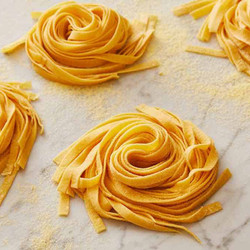On a smooth clean work surface, place 2 cups of the flour in a mound. Using the back of a rounded bowl or large spoon, create a well in the center of the flour large enough for the wet ingredients, about 4 inches wide. Crack the eggs into the well, and add olive oil and salt.
Using a fork, start beating the egg mixture at the center, slowly making your circles bigger to start to incorporate the flour from the sides. Beat gently to try and keep the well from breaking. Continue mixing in the flour until the egg mixture is thickened and starts to form a shaggy mixture.
Using a bench scraper or your hands, fold the mixture together until a shaggy dough ball comes together. Knead the dough by hand until smooth and elastic, about 10 to 15 minutes, adding the remaining ¼ cup of flour 1 tablespoon at a time during kneading if the dough feels sticky at any point. The dough may feel dry and crumbly at the start but should feel smooth and only slightly tacky by the end.
Shape into a ball and wrap the dough ball tightly in plastic wrap. Let the dough rest at room temperature for at least 1 hour and up to 3 hours. Or, refrigerate the dough for up to 24 hours. Bring to room temperature before rolling.
Lightly dust a large baking sheet with semolina flour. (Or, you can use all-purpose flour.)
Cut the rested pasta dough into 4 equal pieces and loosely cover with plastic wrap. Working with one piece of dough at a time, press the dough into a rectangle, about ¼ inch thick. Sprinkle with semolina flour.
Set an electric or hand-crank pasta rolling machine on its widest setting (Number 1). Pass the dough through rollers. Fold the dough in half, and pass through again, feeding the shortest side through the rollers on each roll. Repeat the folding and rolling one more time, then pass the dough through the rollers 2 more times without folding it in half.
Adjust the rollers down to the next setting (Number 2). Pass the dough through the roller 2 times, sprinkling with semolina as needed to keep the dough from sticking.
Continue adjusting the roller thickness and passing the pasta through the rollers twice on each setting, down to the third thinnest setting (Number 6). The pasta sheets will continue to get longer with each pass.
Sprinkle the finished pasta sheet with semolina flour and gently fold it to fit the prepared sheet tray. Cover with a tea towel.
Cut each pasta sheet into the desired shape by either cutting by hand or running them through a pasta cutter attachment. Toss in semolina flour and return to the prepared baking sheet. Uncooked fresh pasta can be formed into small mounds and frozen on a parchment paper-lined baking sheet until solid, then stored in an airtight container in the freezer for up to 1 month. (Cook from frozen.)
To cook the pasta, drop it into a large pot of salted boiling water and cook, stirring occasionally until tender, about 3 to 5 minutes depending on the shape and size of the pasta.
